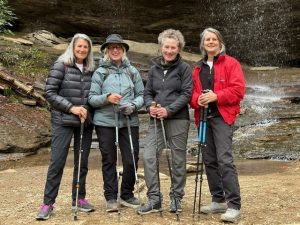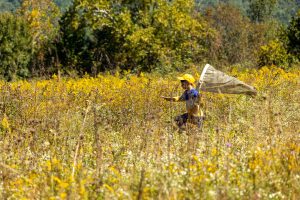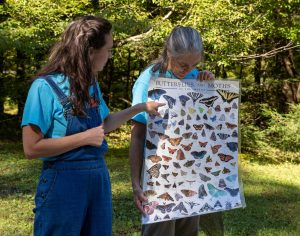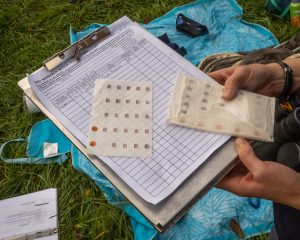
April 30 deadline to apply for Tremont Writers Conference
Frank X Walker and David Brill share a fascination with the Great Smoky Mountains. One

Frank X Walker and David Brill share a fascination with the Great Smoky Mountains. One


As the days grow warmer and the landscape ripples with color, a growing treetop chorus

Two decades ago, thousands of flies, bugs, and beetles met their end in insect traps

In the heart of Great Smoky Mountains National Park, the arrival of spring unveils a
This article has been updated from when it originally ran in October 2022.
Every fall, Great Smoky Mountains National Park plays host to what might best be described as a moving miracle. In the sunny, open valleys around Cataloochee and Cades Cove, iconic monarch butterflies descend to nectar and take shelter in fields of native wildflowers and grasses.

After their pitstop, the butterflies resume their long journey south to the warmer climes of Florida and Mexico, where eastern monarch populations overwinter. Although adult monarchs weigh less than an ounce and may only live for a matter of weeks, they’re capable of covering up to a hundred miles in a single day.
These remarkable butterflies may go unnoticed as they travel in the margins along roadways and across acres farmland, but during their time in the Smokies, they’re greeted by an attentive audience. They may even leave with a souvenir—a tiny mylar tag bearing a tracking number.
“Many, many people have worked on this project since it started in the 1990s,” explains Erin Canter, the manager of science literacy and research at Great Smoky Mountains Institute at Tremont (GSMIT), a nonprofit organization specializing in experiential outdoor education. “We typically start in mid-September and go through the end of October. We’re really trying to catch that curve and understand when they start coming and when they’re gone.”
Tagging monarchs is part of long-running international campaign to help scientists track the intrepid butterflies. Throughout late summer and early autumn, small troops of volunteers participating in the GSMIT’s butterfly education and monarch tagging program assemble in Cades Cove and caravan to one of the winding gravel lanes that bisect the isolated valley. Filing out of their vehicles, the groups prepare themselves with binoculars, spreadsheets, tags, and field guides at the ready. Lightweight mesh butterfly nets hang in the breeze like inverted jellyfish.

“Monarchs are the only ones we tag, but we’re also identifying and counting all the species we find out there. The diversity and colors and behaviors are really astounding,” says Canter. “The goal isn’t just to tag as many monarchs as possible; it’s more about getting people participating in science and connecting to a place—learning more about these species so we can understand and protect them.”
Nearly 2,000 different species of butterflies, moths, and skippers have been documented in the national park according to the All Taxa Biodiversity Inventory—an effort to catalog and identify every species in the Smokies managed by Discover Life in America (DLiA). So many different species can be found in Great Smoky Mountains National Park thanks to its wide range of protected habitats—from wetlands to forests—and both high and low elevations, which helps to extend the flowering season for certain key food sources. Spaces are limited within GSMIT’s butterfly education program in Cades Cove, which is conducted only through the authorization of a special research permit, but DLiA encourages all park visitors to contribute to science in the Smokies by uploading pictures of any butterfly or moth they see in the park using the iNaturalist app.
While eastern monarchs are not federally listed as threatened or endangered, the Xerces Society and other conservation groups point to worrying declines of some overwintering populations. Researchers estimate monarch populations in Mexico have declined by 70 percent and by as much as 95 percent in California. Since monarchs only lay eggs on native milkweed, they are particularly vulnerable to habitat loss from development and ill-timed mowing. Shifting weather patterns as a result of climate change may also interfere with their multigenerational migration.

“Monarchs are not endangered, but what is threatened is their culture of migrating from Mexico to Canada back,” says Canter. “Monarchs need about three weeks of really cold temperatures to reverse their migration and start coming north again. So, if we don’t have those really cold temperatures, we’re don’t know if they’re going to keep coming back north.”
Still, conservationists and Indigenous communities in Mexico have made significant progress within the last decade in the effort to protect key habitats, especially in the state of Michoacán. And several tags carefully affixed to the wings of butterflies by volunteers in the Smokies have been recovered in the mountains of central Mexico, and for centuries, peoples on both sides of the border have appreciated the seasonal spectacle of monarchs on the wing.
“There are all these little stories about how we relate to them or notice them—folks in Appalachia would call monarchs ‘King Billy’,” says Canter, a reference to William III of England, also known as William of Orange. “Day of the Dead also coincides with the return of monarchs, so for the Mazahua people and other Indigenous groups in Mexico, it represents the return of the souls of their ancestors. I think monarchs symbolize a lot.”
“They have inherent value themselves, but I think if we lose them, we’ll genuinely lose something of ourselves as well.”
Join Wanda DeWaard in Cades Cove this Saturday, September 30, at GSMA’s Monarch Tagging Branch Out event. Participants will learn about monarch butterflies as they pass through the Smokies on their annual migration to Florida and Mexico.
The Great Smokies Welcome Center is located on U.S. 321 in Townsend, TN, 2 miles from the west entrance to Great Smoky Mountains National Park. Visitors can get information about things to see and do in and around the national park and shop from a wide selection of books, gifts, and other Smokies merchandise. Daily, weekly, and annual parking tags for the national park are also available.